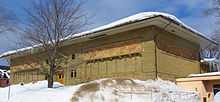John A. Hammond
John A. Hammond (April 11, 1843 – 1939) was a Canadian adventurer, photographer, artist, printmaker and art educator.
Born in Montreal, Quebec, at age nine he began working with his father as a marble cutter. As a young man he joined the local militia and was sent to counterattack an expected Fenian raid that never materialized. Seeking his fortune, in the 1860s he joined in on the Central Otago Gold Rush in New Zealand and spent three years looking for gold. After returning to Montreal, he trained and worked as a staff photographer for the renowned William Notman then joined the Geological Survey of Canada that laid out the route west for the Canadian Pacific Railway. His interest in painting was enhanced by his travels and after becoming a member of the Plymouth Brethren religious sect, his devotion to Christianity would sometimes be reflected in his art.
A member of the Royal Canadian Academy of Arts,[1] he traveled to Dordrecht in South Holland where he painted with James McNeill Whistler and in France, he painted with Jean-François Millet. and later in 1886 exhibited at the Paris Salon, winning two awards. His works were also shown at a number of other important venues including the Royal Academy in London and the National Academy of Design in New York City. Today, examples of his work can be seen in the National Gallery of Canada and some of his photography at the McCord Museum.
John Hammond was a friend of the wealthy businessman and art collector William Van Horne who purchased some of his paintings. Van Horne was president of Canadian Pacific Railway (CPR) and he hired John Hammond to do paintings and murals at CPR hotels and offices depicting scenes from the company's various railroad routes. Hammond traveled via steam ship to China and Japan but these influences are minimal in his art. Some of Hammond's best known works are of the Bay of Fundy and scenes of the harbour at Saint John, New Brunswick with its ever-present fog.

In 1893, Hammond was appointed the head of the Fine Arts Department at Mount Allison University in Sackville, New Brunswick and served as Administrator of the university's Owens Museum of Fine Arts.
In 1929, Montreal department store magnate and avid art collector J. Aird Nesbitt published "John Hammond : A Short Biography of Canada's Oldest Artist."
John Hammond died in 1939 at the age of 96. The "Hammond Gate" at Mount Allison University was his design and is named in his memory. His house in Sackville was designated a National Historic Site of Canada in 1990.[2] In 2002, the town of Sackville 2002 held a "Celebration of John Hammond’s Cultural Gifts" that included an exhibition of his paintings.
References
- ↑ "Members since 1880". Royal Canadian Academy of Arts. Retrieved 11 September 2013.
- ↑ Hammond House. Canadian Register of Historic Places. Retrieved 20 February 2012.
External links
- History of Owens Art Gallery
- Tantramar Heritage Trust
- Google Maps Street View of what is likely to be the old Hammond Gate at 49 York Street, Mount Allison University, Sackville, NB, Canada
|